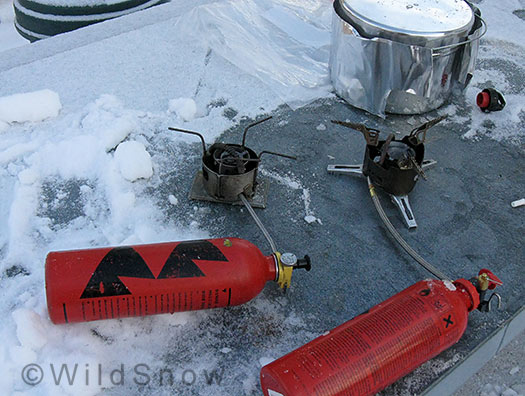Touted as the blow-torch of petrol campfires, the MSR XGK backcountry cook stove has been my hydration savior since it was invented back in the 1970s. So it was with much joy I acquired the latest model, replete with the well engineered fold-out base legs that work super well on a stove board, and the wide pot supports that hold a big snow melting kettle like they were designed for it.

MSR XGK Stoves, venerated elder to left, new EX model to right.
The boys were out on a Denali test camp a few weeks ago, and mentioned that the new XGK didn’t seem to burn quite as hot as the older one they had along. Not only that, but they reported that the new stove kept cutting out on them.
I was less than joyed to hear that, as I’m in the middle of trying to finish our Denali gear acquisition as well as learning how to sat-phone blog, so did I have time for stove repair and testing? Nope. But yeah, with about 30 years of XGK repair, maintenance and testing under my belt, the boys just naturally assumed that Lou would dig in like he was after one of those EU pastries he consumes with such unmitigated gusto. They were right. After all, it’s a lot more fun to fiddle with a stove than test an Iridium phone at a zillion bucks a minute.
We just got a nice 5 1/2 liter snow melting kettle, so I figured what better test than rendering some ice crystals down to liquid? To simulate, I did all testing outside on our snowy porch at temperatures below freezing. I did two different test sessions, one last night and one early this morning. To get extreme, I even stuck the fuel tank in our freezer last night and brought it down to zero Fahrenheit.
First, the good news is I couldn’t get the new model XGK EX to quit without abusing it. The stove did quit when I dripped water on the burner, or over pressured and went full throttle before the stove was warm. Also, I discovered that the fuel diptube was reversed in orientation, so once the bottle was half empty the stove would indeed cut out. That’s probably what happened to the boys, as I couldn’t get anything else to occur.
Now, for the not so good. In a number of tests last evening, the new XGK melted snow to 5 liters of water in 18 minutes. That’s not terrible, but to my tuned ear and well educated sense of what an XGK should do, the stove seemed to not be quite the blow torch I’m used to. So I grabbed the 20 year old XGK from our gear museum, stuck in a new jet, fired it up, and yeah! The flame was noticeably higher, louder, and cleaner looking. It melted the same snow to 5 liters water in just under 17 minutes. I did the whole test twice. The new model is thus about 6% slower.
To be sure something weird wasn’t going on, I removed both the jet shaker/cleaner and the fuel filter from the new XGK. The old one has neither of those “features,” (remind you of a software “upgrade?”).
So, is one minute more melting time per 5 liters snowmelt worth bringing the nicely designed new XGK model? Or should we just acquire some older stoves? Main thing is that we bring all the same model of stove, so we don’t get confusion with repair kits and such. Also, the better base and pot supports of the newer XGK EX model eliminate a lot of hassle, not to mention keeping the stove up off the stove board so we don’t need as much heat resistance in the stove board. Thus, this is an important decision. But a decision I’m surprised we have to make.
My recommendation is we go with the new model. The numbers work something like this: If we run two snow melting stoves, one stove will have to melt about 32 liters of snow a day (to be liberal, as we’ll also have two cooking stoves going and can melt with those as well). That means the melt time (not the boil time) will be around two hours a day. Enhance that by 6% and the day’s snow melting for our expedition would take around 7 minutes less if we used the older model stoves. Clincher is that the older stoves also require more fiddling with the supports, and since they sit on the stove board you have to be a lot more careful when you prime them so as not to burn the stove board. In all, my bet the time factor is a wash. But why can’t Cascade Designs eak a bit more heat out of the new model? Indeed, why in the world didn’t they INCREASE the output a bit over the previous model? Strange.
WildSnow.com publisher emeritus and founder Lou (Louis Dawson) has a 50+ years career in climbing, backcountry skiing and ski mountaineering. He was the first person in history to ski down all 54 Colorado 14,000-foot peaks, has authored numerous books about about backcountry skiing, and has skied from the summit of Denali in Alaska, North America’s highest mountain.
